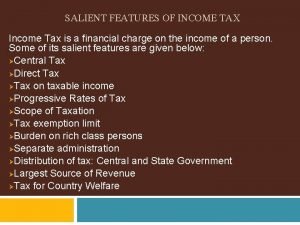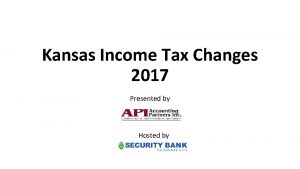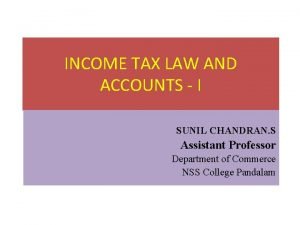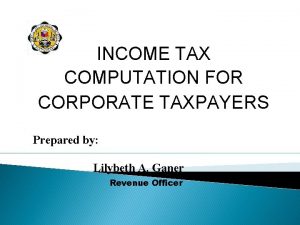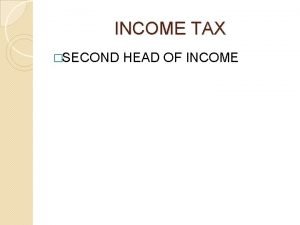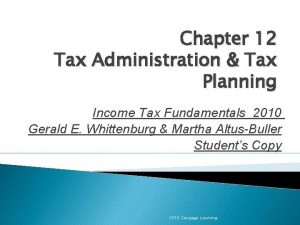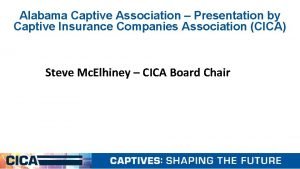CAPTIVE REITs Captive REITs and State Income Tax











- Slides: 11

CAPTIVE REITs Captive REITs and State Income Tax Avoidance by Joe Garrett, Alabama Dep’t of Revenue MTC ATTORNEY’S CONFERENCE CALL JANUARY 25, 2007 Note: The tax avoidance examples contained herein are examples of common tax avoidance structures, but are not based on a specific taxpayer. 1

Captive REITS 2

Captive REITs – Two Types Type One – Rental REIT Type Two – Mortgage REIT ØCommon to large multi-state retailers ØCommon to the multi-state banking industry ØREIT holds real property directly ØREIT holds mortgages or mortgage backed securities ØIn-state operating company / taxpayer shifts income to REIT through rent expense payments ØREIT files state income tax return, but shelters income with the dividends paid deduction (DPD) ØMortgage interest that used to accrue at the in-state bank / taxpayer now accrues at the REIT ØREIT may or may not file state income tax return – if so it shelters income with the dividends paid deduction (DPD) 3

Captive REIT – Rental REIT Structure Dividend Retailer / Taxpayer $$ RENT REIT Hold. Co Dividend REIT • The REIT ostensibly “owns” store locations used by Retailer. • Retailer shifts income to REIT through rental payments. • REIT avoids state income tax liability b/c of the dividends paid deduction for REITS. • REIT Hold. Co avoids tax on the dividend b/c it is located in a state that allows a DRD, a no tax state, or a combined return state where the dividend is eliminated. 4

Captive REIT – Mortgage REIT Structures AL Taxpayer • Taxable Mortgage Income AL Taxpayer • DRD REIT Hold. Co REIT • Dividend Paid Deduction Mortgage Income • Tax Haven REIT • Dividend Paid Deduction Mortgage Income 5

Captive REITs – Basic State Tax Issues DPD / DRD Double Deduction ØFederal income tax REIT law attempts to eliminate one level of taxation by allowing a REIT to deduct dividends paid. ØThe necessary corollary of the REIT DPD is that a REIT shareholder is not allowed a DRD for any dividend received from a REIT. This principle is codified in multiple places within the IRC. ØCaptive REIT structures often attempt to exploit state income tax systems that: Ø adopt federal REIT treatment at the REIT level – ie the state allows a DPD, BUT Øhave not explicitly conformed their dividends received deduction (DRD) to make REIT dividends non-deductible for REIT owners. ØCaptive REITs attempt to achieve a double deduction. 6

Captive REITs – Basic State Tax Issues Transforming Income from Real Property into Income from an Intangible Ø Rental REITs transform income attributable to real property (rent), and taxable in your state, into a dividend that is likely not taxed anywhere. ØRent accrues at the REIT where any potential income tax is eliminated by the DPD. ØThe dividend received by the REIT owner is not taxed because: ØNon-IRC conforming DRD allows REIT dividend double deduction, or ØREIT owner is located out of state in a tax haven or a combined return jurisdiction. 7

Captive REITs – Basic State Tax Issues Mortgage REITs – “Belt and Suspenders” Protection ØMortgage REITs, like other captive REITs, often take advantage of the DRD / DPD double dividend deduction. ØBut unlike other captive REITS, mortgage REITs can avoid an instate filing obligation because they own intangibles (mortgages or mortgage backed securities) not real property. ØMortgage REITs function like, and essentially are, investment holding companies that can attempt to isolate themselves in a tax haven or a combined return jurisdiction. ØLikewise the REIT owner / taxable dividend recipient may be an intermediate subsidiary holding company lacking in-state nexus creating contacts. 8

Captive REITs – DOR Challenges ØREIT owner not entitled to the DRD double deduction. See Massachusetts Banc. Boston case. ØCaptive REIT not entitled to REIT status and DPD. See the Massachusetts Fleet Funding case. ØSham / Business Purpose / Economic Substance arguments ØWas the property transferred to the REIT? Was transfer recorded? ØWho are the shareholders? Employees? Charities? ØDoes the REIT satisfy the IRC 100 shareholder rule? ØDeny the REIT DPD using an add-back statute. ØIs the DPD an intangible expense? ØDeny the rent expense deduction to the operating company. ØIs property recorded in operating company’s name? ØNexus with the REIT owner? See Louisiana Auto. Zone. 9

Captive REITs – Legislative Fix ØMTC beginning work on uniform state income tax REIT provisions. Ø All state dividend received deductions should deny the deduction for dividends received from a REIT – ie. conform to federal DRD. ØConsider denying DRD for dividends received indirectly from a REIT (dividends that are “cleansed” by passing through a REIT holding company). ØState REIT provisions should define “Captive REITs” and deny REIT treatment – the DPD – to Captive REITs. Ø“Captive REIT” should mean any REIT with an 80% or greater (vote or value and including attribution) shareholder. 10

Captive REITS QUESTIONS? 11







